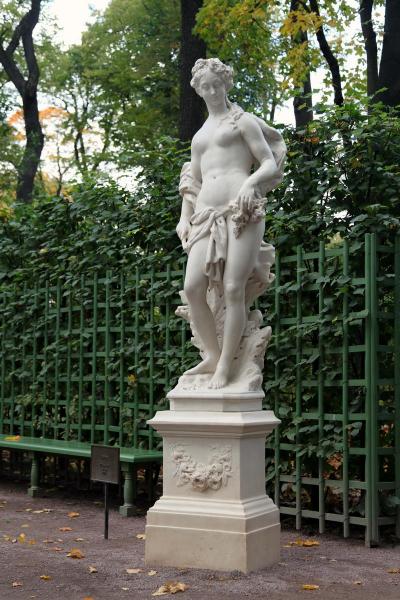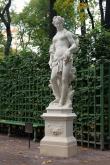Aurora
Копия с оригинала Д. Бонацца. Италия. 1717
- Artificial marble. 202 х 76 х 52
- Location in museum The Summer Garden
- Period Late 17th century – the 18th century
- CategoryMythological Subject
- Share
|
A series of sculptures “Circle of Day” was performed by a talented sculptor Giovanni Bonazza. Night and sunrise, midday and sunset, following one another, mark the everlasting circle of day and night on the earth. Shining “Aurora”, radiant “Midday”, gloomy “Sunset”, wise thoughtful “Night” allegorically depicted four times of the day and were meant to be established on the roof of the Grotto. An album of painting was preserved, sort of an accompanying document, in which an unknown Italian painter pictured statues and busts ordered by Peter the Great in Italy. The names of the sculptures and the masters who created them are mentioned in this album. On the paintings from this album the sculptures depicting times of the day are featured with wings, but their wings were not preserved. Aurora – the goddess of dawn in Roman mythology. Daughter of Nyx (Night). Sister of the Sun (Helios) and the Moon (Selene). She is depicted as a young woman in a crown of roses and a torch in her right hand. In her left hand the goddess holds the flowers that open up on early mornings when the first drops of dew appear. Aurora opened the gates of the day and preceded the appearance of Helios’ sun chariot. She was usually featured winged, often riding a chariot drawn by horses (sometimes – winged, too); dressed in red and yellow, sometimes with a sun-disk over her head and a gloriole or a halo of sunbeams around her brow, or with a torch in her right hand; sometimes also with vessels of dew in her hands. Bonazza, as a baroque master, wonderfully shows the light motion and masterfully transmits dynamics to the image. We see a symbol of a wonderful beginning of the day and the morning of human life. |

